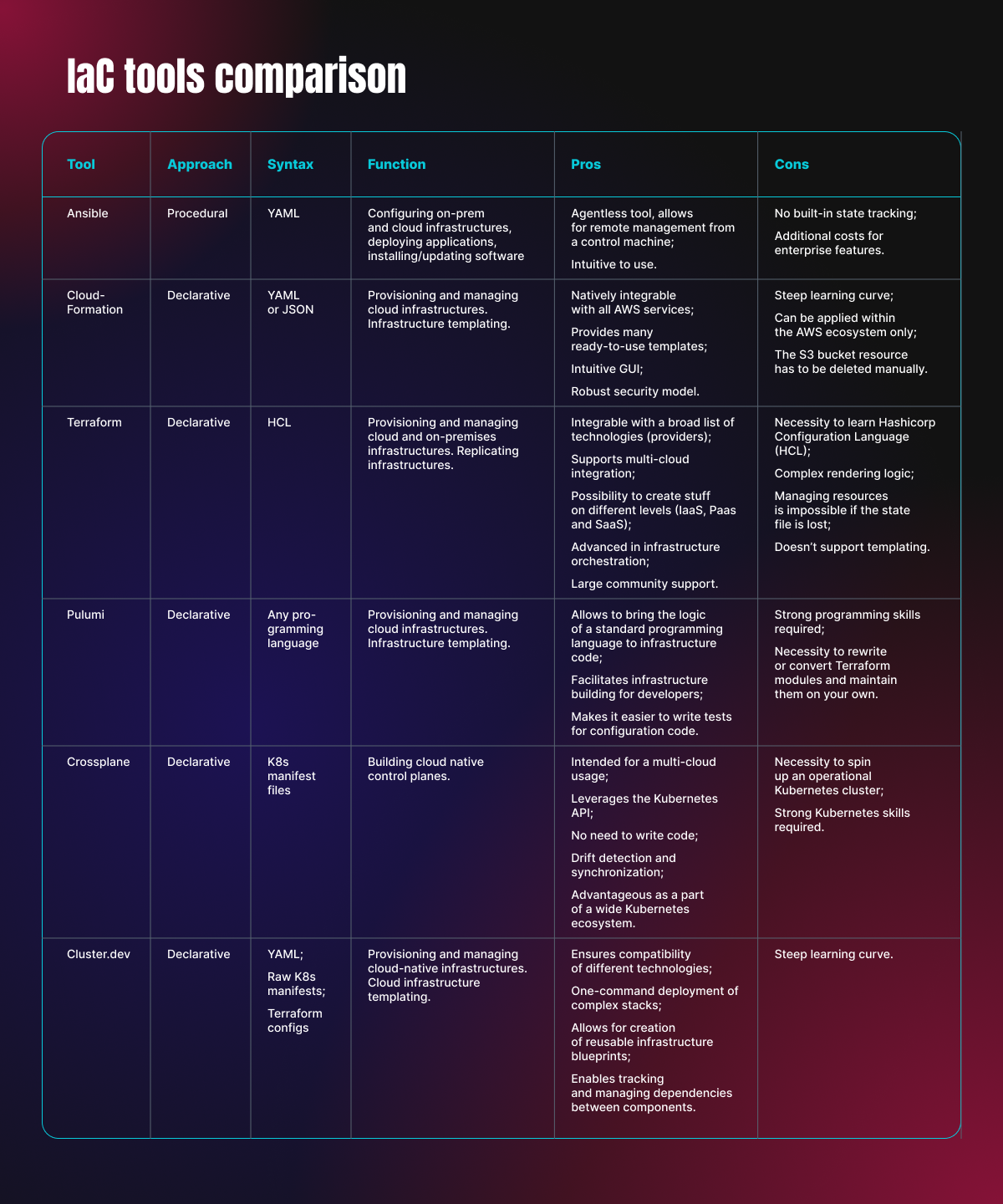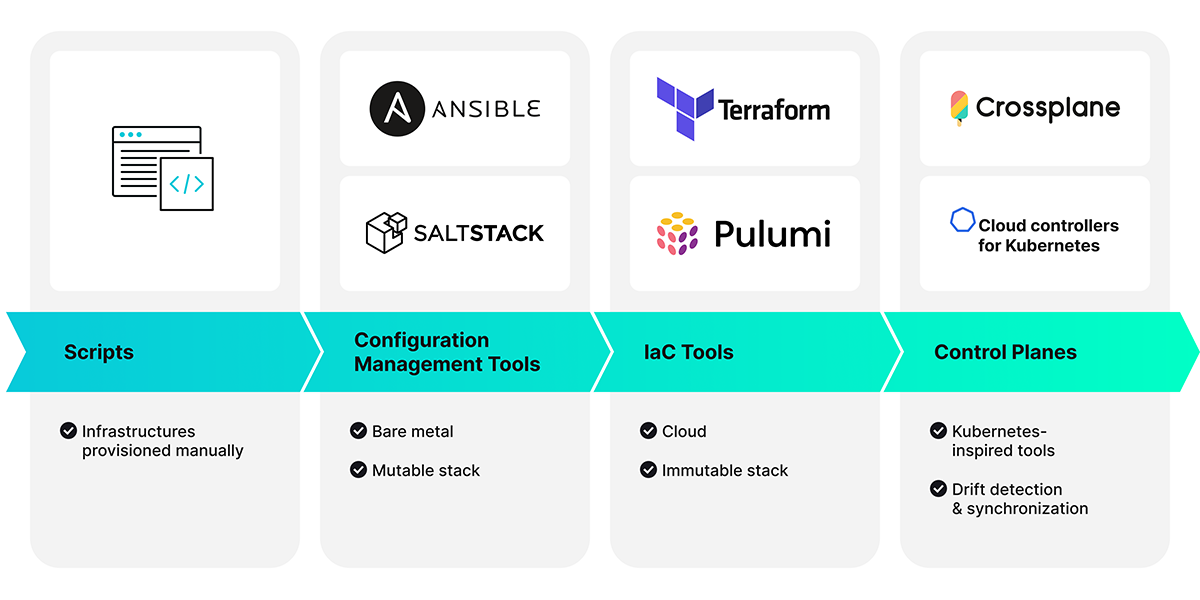Infrastructure as Code (IaC) is an essential practice that has become inherent in modern multi-component environments. This is the approach that streamlines deployments and reduces the chances of human error through automation of infrastructure setup and management.
In this article, we will explore what IaC is, focusing on its core principles, pros and cons, and future trends. We will also introduce popular IaC tools, explaining their basic functions and highlighting the differences between them.
Factors that set the scene for IaC
The mass adoption of cloud computing has significantly contributed to the rise of IaC that enabled efficient control over the growing number of cloud infrastructures’ components. Several factors have been vital in shaping the IaC concept:
- Shift to cloud-native development: The widespread use of containers has led to the rise of immutable infrastructure, an approach to provisioning that replaces virtual resources instead of modifying them. IaC has enabled the codification of infrastructure resources as templates, allowing for quick and easy setup of new environments.
- Need for automation in modern stacks: Modern infrastructures can consist of hundreds of components, making manual provisioning a daunting and impractical task. IaC introduced automation that allows organizations to manage their infrastructure at scale, avoid configuration drift, and swiftly apply changes across multiple environments.
- Increased role of developers in operations processes: In the cloud-native world, developers are increasingly required to handle provisioning tasks. IaC simplifies these operations, allowing developers to spin up ready-to-go infrastructures by merely executing scripts. Additionally, the accountability and transparency provided by IaC foster better collaboration between development and operations teams.
- Need for swift infrastructure changes: The dynamic nature of cloud environments demands infrastructures that can be rapidly spun up, scaled, and taken down as needed. IaC facilitates this flexibility, with all modifications being implemented through updates to configuration files.
Understanding Infrastructure as Code
Definition and principles
Infrastructure as Code (IaC) is a practice that involves managing and provisioning computing infrastructure through machine-readable configuration files instead of manual configuration. By introducing automation throughout all infrastructure processes, IaC reduces manual tasks while ensuring the consistency, repeatability and scalability of infrastructure setups.
The fundamental idea behind IaC is straightforward: treat your infrastructure as you would software and data. This means applying the same practices used in software development to your infrastructure, including version control, testing infrastructure code, and implementing continuous integration and deployment.
How IaC works
IaC is implemented through specific tools that automate system provisioning using their internal algorithms. Depending on the approach, IaC can be executed either declaratively or imperatively. Let’s take a closer look at these two methods.
Imperative approach
The imperative, or procedural approach is a “how” method: it focuses on outlining the precise steps needed to achieve the desired outcome. Therefore, it implies providing detailed instructions or scripts that specify the exact order in which to execute tasks. This approach allows for granular control over configuration and deployment by detailing each step; however, it requires advanced coding skills from engineers.
Declarative approach
In contrast, the declarative approach emphasizes the “what” rather than the “how.” Using a domain-specific language, engineers specify the desired end state in configuration files, leaving it to machines to decide what needs to be done and in which way to achieve this. The declarative code is easier to manage and requires fewer coding skills.
IaC tools
There is a wide range of tools available for implementing IaC, each designed for different use cases and offering various approaches, configuration methods, scripting languages, and file formats.
Early IaC tools were more procedural, focusing on the specific steps required to reach the desired state, such as Chef and Ansible. Their code contained elaborate instructions, and so was difficult to read and understand.
With cloud-native development the trend moved towards a more declarative style of IaC, with tools like Terraform and AWS CloudFormation leading the way. Their code is lighter and more readable as it consists primarily of configuration settings.
The big advantage of declarative tools is their ability to store state: by constantly comparing the actual state with the desired one, they “know” when something fails and act to reconcile the state. The continuous drift check performed by declarative tools allows them to identify what needs to be changed, added, or created.
The table below highlights popular IaC tools and summarizes their most distinctive features.

Benefits of Infrastructure as Code
Implementation of the IaC practice allowed to efficiently address the following challenges:
- Consistency and repeatability. One of the main issues with manual infrastructure setup is its unpredictability: the same script may yield different outcomes every time it is executed. In contrast, codifying infrastructure provides a template that ensures you can deploy the same set of resources repeatedly, achieving consistent results across different cloud platforms.
- Speed and efficiency. IaC takes a huge load off engineers by automating the tasks of configuring, deploying, or redeploying infrastructure after every change. With IaC, you can quickly apply a single configuration across multiple environments. When updates are needed, you simply adjust the configuration files, and the IaC tools handle the deployment and provisioning automatically.
- Keeping up with changes and updates. Manual infrastructure setup can make tracking changes a guessing game for the rest of the team: it’s hard to know who made what changes and why. By keeping infrastructure code in a version control system (VCS), IaC provides clear visibility of changes, fostering better collaboration between teams.
- Fewer Mistakes. IaC helps ensure higher quality code through VCS-enabled code reviews. Since changes to infrastructure are made via code that undergoes checks, the risk of crashing the infrastructure by making direct changes is significantly lower.
- Documentation. IaC code is clean and readable by both machines and humans. Additionally, it’s self-documenting, providing a clear overview of existing resources and configurations.
- Cost Optimization: IaC provides a complete inventory of your cloud resources, detailing which services run on which platforms. Regular code reviews enable you to identify idle resources and shut them down, helping to optimize costs.
Challenges
Adherence to routine. When implementing IaC, it’s crucial to strictly adhere to the rules and practices agreed upon with your team. Although it may be tempting to make quick minor changes manually instead of following all the procedural steps of the IaC pipeline, doing so undermines the core principle of IaC. At first avoiding manual changes might seem like a longer road, but ultimately it saves time in the long run.
Time investment in learning. Adopting any new technology, no matter how user-friendly, demands a significant investment of time and effort for successful onboarding. When working with IaC tools, you need to understand their unique logic and domain-specific languages, which can vary from tool to tool. Achieving proficiency with these tools requires a certain level of commitment and time investment in the beginning.
Spread of mistakes. If unnoticed, an error in the codebase can be automatically propagated across multiple environments, leading to widespread misconfiguration and other issues.
Future trends
Victor Farcic, a Developer Advocate at Upbound, believes that the future of IaC tools is closely related to Kubernetes. This technology has become so deeply ingrained in modern IT environments that it will eventually operate behind the scenes, much like hypervisors: everyone who creates a virtual machine in the cloud uses them, often without even knowing they exist. According to Farcic, the current IaC toolkit will evolve into a new generation of tools called control planes. These tools will feature drift detection and automatic synchronization, allowing machines to detect changes in the current state and remediate them without waiting for human command. Additionally, these tools will leverage the Kubernetes API and a broad ecosystem of integrable tools.
Among the tools that extend Kubernetes will also be cloud controllers for Kubernetes: provider-specific tools designed to define and use cloud resources directly from Kubernetes. One such example is AWS Controllers for Kubernetes (ACK). These tools operate by making the Kubernetes API extensible to include resources outside of Kubernetes. With cloud controllers, you can describe the required resources in a Kubernetes manifest, enabling the Kubernetes API to create them, rather than creating them via the cloud console.

IaC tools evolution diagram
The growing trend to multi-cloud strategy will drive the rise of cross-cloud functionality that enables seamless integration of stacks running on different platforms. IaC tools with cross-cloud capabilities will be in the highest demand as organizations seek the most efficient ways to manage infrastructure across diverse platforms.
Conclusion
Infrastructure defined as code offers many advantages over manual provisioning, including version control, testing, faster provisioning, and software delivery. In the era of cloud-native computing, it’s no overstatement to say that IaC has become a cornerstone of modern IT strategy. As a key DevOps practice, it introduces automation at the infrastructure level. Its integration with established technologies like Kubernetes is paving the way for the emergence of more autonomous systems capable of self-optimization.
If you consider the future of your cloud infrastructure management, start your journey with SHALB and explore our comprehensive IaC services. Discover how SHALB can streamline your infrastructure setup and management, ensuring a seamless and optimized cloud experience.


